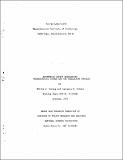Automobile safety regulation : technological change and regulatory process
Author(s)
Lorang, Philip Alphonse; Linden, Lawrence Howard.
DownloadMIT-EL-77-036WP-04146793.pdf (8.532Mb)
Metadata
Show full item recordAbstract
This report examines the history of automobile safety regulation since 1966, viewed as an attempt to substitute public decisions on the design of new automobiles for private decisions. The focus of the
examination is on the problems which confront regulators in the National Highway Traffic Safety Administration (NHTSA) in their attempt to affect the design and performance of automobiles and on the effect regulation
has actually had on automotive technology.
Congress gave the NHTSA two ways of bringing about changes in the design and performance of automobiles. The NHTSA may set mandatory
performance standards for automobiles and may conduct research and development on new automobile safety technology. Congress did not set a programmed goal that was to be achieved through these methods, however.
Instead, the NHTSA must continually decide in an ad hoc fashion the desirability of particular changes in the attributes of new cars. Those that it finds desirable must be forced into practice through standards.
The purpose of the agency's R&D is to make possible for the first time additional changes in vehicle attributes which the agency may then choose to force into practice as well.
Several inherent problems in developing the technical requirements in proposals for new standards and in judging the desirability of
proposals have not been fully resolved by the NHTSA. They have had a detrimental effect on the number and quality of standards promulgated since the initial set. The agency's efforts in developing new technology
have also faced problems and have so far not contributed to its standards. In order for regulatory action to be taken, policy decisions must be made to compensate for uncertainties in predictions of the impacts of. proposed standards. Policy decisions must also be made as to the desirable balance between reductions in traffic risks and increased costs. The uncertainties could be reduced if more reliance were placed
on large-scale experimental testing of contemplated safety modifications
in actual use. The policy choices that would remain, of both types, could be improved if they were recognized as such and the process for making them opened up to greater outside inspection and participation.
Date issued
1977-10Publisher
MIT Energy Laboratory
Other identifiers
04146793
Series/Report no.
MIT-EL77-036WP
Keywords
Automobiles |x Safety measures, Automobiles |x Technological innovations., Automobiles |x Law and legislation |z United States
Collections
The following license files are associated with this item: